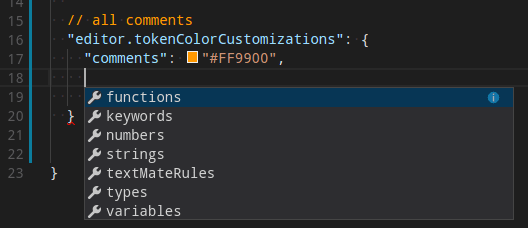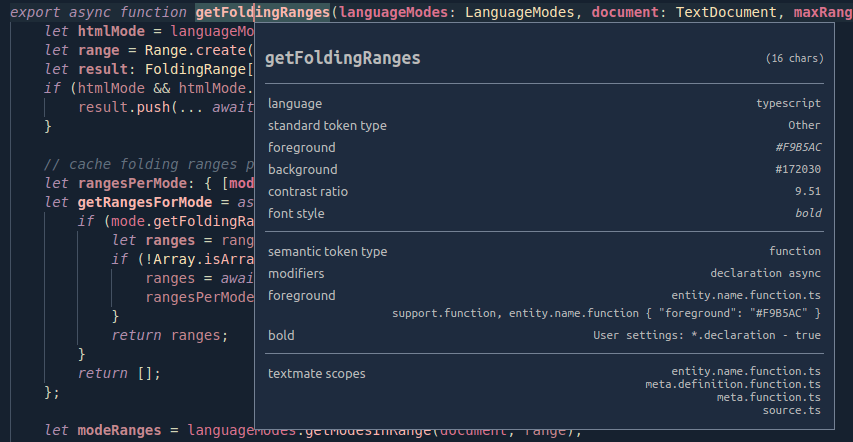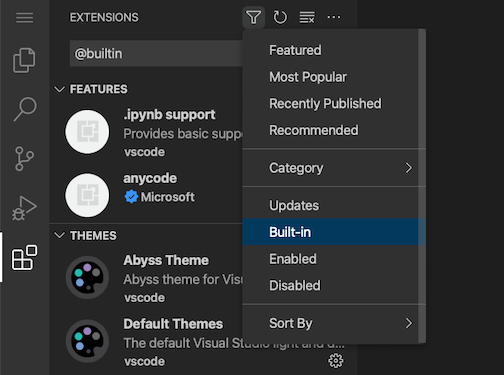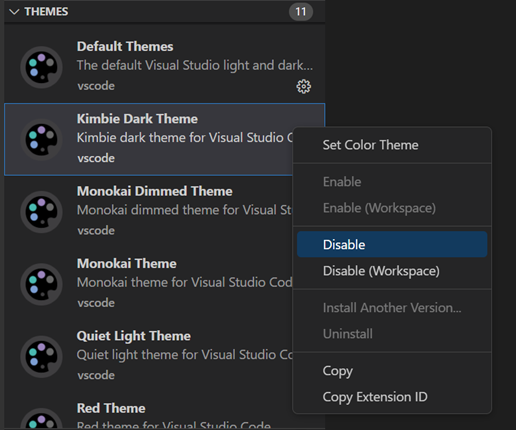-
VSCodium > Les thèmes
- line 10:
languageModesis colored as a parameter. - line 11:
RangeandPositionare colored as classes anddocumentas a parameter. - line 13:
getFoldingRangesis colored as a function. trueandfalseturn semantic highlighting on or off for all themes.configuredByThemeis the default and lets each theme control whether semantic highlighting is enabled or not. All the themes that ship with VS Code (for example, the "Dark+" default) have semantic highlighting enabled by default.- Select the File > Preferences (Code > Preferences or Code > Settings on macOS) > Theme > File Icon Theme menu item, or use the Preferences: File Icon Theme command to display the File Icon Theme picker.
- Use the Up and Down keys to navigate through the list and preview the icons of the theme.
- Select the theme you want and press Enter.
- Select the File > Preferences (Code > Preferences or Code > Settings on macOS) > Theme > Product Icon Theme menu item, or use the Preferences: Product Icon Theme command to display the Product Icon Theme picker.
- Use the Up and Down keys to navigate through the list and preview the icons of the theme.
- Select the theme you want and press Enter.
- Settings - Learn how to configure VS Code to your preferences through user and workspace settings.
- Snippets - Add extra snippets to your favorite language.
- Extension API - Learn about other ways to extend VS Code.
- Color Theme - Color Theme extension API.
- File Icon Theme - File Icon Theme extension API.
Sélectionner un thème
Fichier > Préférences > Theme > Color Theme menu item, ou bien CTRL+K CTRL+T (Préférences: Color Theme).
ûtiliser les flèches du clavier to navigate through the list and preview the colors of the theme.
The active color theme is stored in your user settings (keyboard shortcut Ctrl+,).
"workbench.colorTheme": "Solarized Dark"
Tip: Le theme is stored in your user settings and applies globally to all workspaces. You can also configure a workspace-specific theme. To do so, set a theme in the Workspace settings.
Modifier un thème
Workbench colors
workbench.colorCustomizationspour modifier l’aspect général de VSCodiumeditor.tokenColorCustomizations pourmodifier uniquement l’éditeur{ "workbench.colorCustomizations":{ "activityBar.foreground": "#00ff00", # couleur pour les icônes à gauche "activityBarBadge.background": "#8400ff" } }List of all customizable colors, see the Theme Color Reference.
To make customizations to a specific theme, use the following syntax:
"workbench.colorCustomizations": { "[Monokai]": { "sideBar.background": "#347890" } }If a customization applies to more than one theme, you can name multiple themes or use
*as a wildcard at the beginning and end of the name:"workbench.colorCustomizations": { "[Abyss][Red]": { "activityBar.background": "#ff0000" }, "[Monokai*]": { "activityBar.background": "#ff0000" } }Editor syntax highlighting
To tune the editor’s syntax highlighting colors, use
editor.tokenColorCustomizationsin your user settingssettings.jsonfile:
A preconfigured set of syntax tokens (‘comments’, ‘strings’, …) is available for the most common constructs. If you want more, you can do so by directly specifying TextMate theme color rules:

Note: Directly configuring TextMate rules is an advanced skill, as you need to understand how TextMate grammars work. Go to the Color Theme guide for more information.
To customize specific themes, you can do this in one of the following ways:
"editor.tokenColorCustomizations": { "[Monokai]": { "comments": "#229977" }, "[*Dark*]": { "variables": "#229977" }, "[Abyss][Red]": { "keywords": "#f00" } }Editor semantic highlighting
Some languages (currently: TypeScript, JavaScript, Java) provide semantic tokens. Semantic tokens are based on the language service’s symbol understanding and are more accurate than the syntax tokens coming from the TextMate grammars that are driven by regular expressions. The semantic highlighting that is computed from the semantic tokens goes on top of syntax highlighting and can correct and enrich the highlighting as seen in the following example:
The "Tomorrow Night Blue" color theme without semantic highlighting:

The "Tomorrow Night Blue" color theme with semantic highlighting:

Notice the color differences based on language service symbol understanding:
The settings
editor.semanticHighlighting.enabledserves as the main control on whether semantic highlighting is applied. It can have valuestrue,false, andconfiguredByTheme.You can override the theme setting by:
"editor.semanticTokenColorCustomizations": { "[Rouge]": { "enabled": true } }When semantic highlighting is enabled and available for a language, it is up to the theme to configure whether and how semantic tokens are colored. Some semantic tokens are standardized and map to well-established TextMate scopes. If the theme has a coloring rule for these TextMate scopes, the semantic tokens are rendered with that color, without the need for any additional coloring rules.
Additional styling rules can be configured in
editor.semanticTokenColorCustomizations":"editor.semanticTokenColorCustomizations": { "[Rouge]": { "enabled": true, "rules": { "*.declaration": { "bold": true } } } }To see what semantic tokens are computed and how they are styled, you can use the scope inspector (Developer: Inspect Editor Tokens and Scopes), which displays information for the text at the current cursor position.

If semantic tokens are available for the language at the given position and enabled by theme, the inspect tool shows a section semantic token type. The section shows the semantic token information (type and any number of modifiers) and the styling rules that apply.
More information on semantic tokens and styling rule syntax can be found in the Semantic Highlighting Guide.
Create your own Color Theme
commande > Developer: Generate Color Theme From Current Settings
VS Code’s Yeoman extension generator helps you generate the rest of the extension.
See the Create a new Color Theme article in our Extension API section to learn more.
Retirer des Themes
Disable them from the Extensions view (Ctrl+Shift+X). Select the Filter Extensions button from the top of the Extensions view, select the Built-in option, and you see a THEMES section that lists the default themes.

You can disable a built-in theme extension, as you would any other VS Code extension with the Disable command on the gear context menu.

File Icon Themes
File icons indicate a particular file type. These icons are shown alongside the file name in the Explorer view and in tabbed headings. File Icon Themes can be contributed by extensions.
To select a different File Icon Theme:

By default, the Seti File Icon Theme is used and those are the icons you see in the Explorer view. VS Code remembers your File Icon Theme selection across restarts. You can disable file icons by selecting None.
VS Code ships with two file icon themes: Minimal and Seti. To install more File Icon Themes, select the Install Additional File Icon Themes item in the File Icon Theme picker, which opens the Extensions view, filtered by icon themes.
You can also browse the VS Code Marketplace site directly to find available themes.
The active File Icon Theme is persisted in your user settings (keyboard shortcut Ctrl+,).
// Specifies the file icon theme used in the workbench. "workbench.iconTheme": "vs-seti"Create your own File Icon Theme
You can create your own File Icon Theme from icons (preferably SVG), see the File Icon Theme article in our Extension API section for details.
VS Code for the Web
VS Code for the Web provides a free, zero-install VS Code experience running entirely in your browser at https://vscode.dev.
You can share and experience color themes through VS Code for the Web through the URL schema:
https://vscode.dev/editor/theme/<extensionId>.For instance, you can go to https://vscode.dev/editor/theme/sdras.night-owl to experience the Night Owl theme without having to go through the download and install process.
You can learn more about previewing and sharing themes with in the VS Code for the Web documentation.
Product Icon Themes
Product Icon Themes enable you to change the icons in the VS Code user interface, other than the icons for specific file types. For example, you can modify the icons for the views in the Activity Bar, or the icons in the title bar for changing the layout.
Notice in the following image how the Activity Bar icons are updated when selecting a different Product Icon Theme.

To select a different Product Icon Theme:
Next steps
Themes are just one way to customize VS Code. If you’d like to learn more about VS Code customization and extensibility, try these articles:
- line 10: